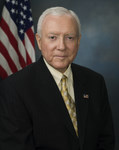
Congress and the Internal Revenue Service are starting to take a closer look at the museums set up by private foundations that receive special tax-exempt status from the IRS.
Sen. Orrin Hatch, R-Utah, chairman of the Senate Finance Committee, released the results of a review Thursday into the activities of tax-exempt private museums. Last November, he launched an inquiry seeking answers from 11 private foundations about how accessible they were making the collections in their museums available to the general public.
The answers varied widely, with some of the museums set up by private foundations welcoming up to half a million visitors a year to come in and appreciate their collections year round. On the other hand, some of the tax-exempt private museums stayed closed for renovations for months at a time and, when they were “open,” the visiting hours were highly irregular. In some cases, visitors needed to make appointments to see the collections far in advance, limiting the facilities’ accessibility. That accessibility usually wasn’t a problem for the collectors who set up such museums, since in some cases the “museum” was nearby the estate where the donors lived or even on the same premises.

Orrin Hatch
“These factors alone are not cause for revoking tax-exempt status or imposing tax on self-dealing, but they do raise questions about the nature of the relationship between the donor and museum that perhaps merit further scrutiny,” Hatch said in a statement. “Despite the good work that is being done by many private museums, I remain concerned that this area of our tax code is ripe for exploitation.”
Hatch’s investigation came on the heels of a report in The New York Times last year on facilities like the Brant Foundation Art Study Center, nearby the Greenwich, Conn., estate of its benefactor, Peter Brant, and the Glenstone museum in Potomac, Md., also near the home of its creator, Mitchell Rales, but behind a gate and guardhouse. Hatch surveyed these facilities along with better known ones like Eli and Edythe Broad’s splashy new museum, The Broad, in Los Angeles.
Hatch summarized the findings in a letter last week to IRS Commissioner John Koskinen
“I was pleased to learn that some private museums welcome as many as 500,000 visitors each year to view their artwork free of charge; some have steadily increased their attendance and are expanding their facilities to make collections more accessible to the public; others engage in robust loan programs that make their art available in museums worldwide; others have active grant programs that support artists and art education organizations; and others are exploring ways to make their collections viewable online,” he wrote. “On the other hand, some of the museums I surveyed are not readily accessible by the general public. Of particular concern are lightly advertised museums that require reservations made weeks or months in advance, thereby effectively narrowing the visitor pool to a small group of patrons. I am also concerned by the short hours that some museums keep—some are open to the public for as little as 20 hours each week—and the extended periods that some museums are closed entirely to the public, as long as two or three months at a time.”
Clearly, museums that receive tax benefits in the form of tax-exempt status should be making their collections more readily accessible to the public. While it is understandable that such facilities would want to protect their holdings and ensure the security of multimillion-dollar art collections, and they may need time to renovate when setting up a new exhibition, it is also important that taxpayer dollars aren’t misused to subsidize wealthy art collectors’ investments.
Do you think foundations dedicated to private art collections should receive tax-exempt status?